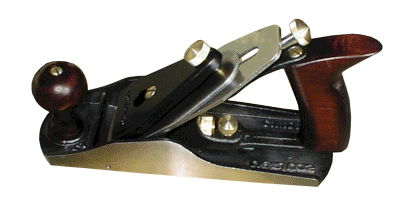|
|
|
| First I have to disqualify myself as any sort of
hand-plane expert. I only have a few planes and I don't use the ones I have frequently. My
hand plane use tends to fall into the category of trim work mainly. I received my plane in good condition, there really wasn't anything to do to it to get it ready to work, even the blade was sharp! I'm not one to hand-lap soles or polish mating parts to mirror finishes. I'm not above doing a few simple things to prep a tool but this one required none of that, it was ready to use right out of the box. |
 |
| The Veritas #4 ½ is basically intended to be a
general purpose bench plane with greater width and built sturdily enough to take the
forces one would rather not apply to smaller planes. The feel and heft of the plane is
significantly better than the Stanley plane I was used to using and the overall fit and
finish very good. About the only down side is that the handles aren't quite as pretty as
some of the more expensive planes. The #4 ½ is somewhat different than the typical Stanley style planes. It has a moveable frog to position the blade within the mouth (opening). The frog, bed for the blade, and handle are all part of the same assembly separate from the rest of the plane body. The handle in particular is tied to this assembly at both the top and bottom. Other planes of this type are bolted to the sole of the plane at the bottom only. Supposedly the way the handle is attached allows for better operation by allowing one to transmit force more directly to the work. I don't know if that is true or not but the handle has a very rigid feel to it. The blade adjustment mechanism allows for both lateral and depth changes. Changing either is very precise with minimal backlash in the depth adjustment. Like their block plane, the #4 ½ has two small set screws in the body which constrain the blade laterally. I think these screws are one of the best ideas the Veritas brand planes have; my theory is that they help stabilize the blade as well. The blade is held in place by a thick cap, it supports the blade almost all the way to the cutting edge. This seems like a fundamentally better way of holding the blade to the body, much better than the comparatively anemic Stanley cap design. The plane works fairly well but not as good overall as the ECE Smoother plane. I occasionally experience some chatter at the beginning of a cut but I believe that is due mostly to the short sole length before the blade and my technique. Chips also have a tendency to build up in the plane, mainly because my hand partially covers their egress. Aside from that the plane is okay, certainly not the best I own.
|
|